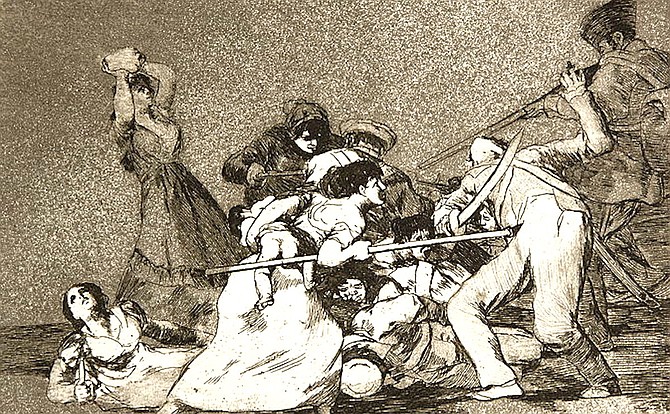 Facebook
Facebook
 X
X
 Instagram
Instagram
 TikTok
TikTok
 Youtube
Youtube

During the shelter-in-place era, I’ve been covering a lot of ground, relative to my normal consumption, in the realm of high culture. I’ve read books which I’ve been putting off for years such as Death in Venice, A Portrait of the Artist as a Young Man, and Ulysses. I’ve made some discoveries along the way such as the hilarious Three Men in a Boat by Jerome K. Jerome.
In addition to my late-blooming literary efforts, I’ve begun pairing pieces of music with pieces of art. One of the results of this exercise was the discovery of a strong correlation between the art of Federico Goya and the music of Ludwig Beethoven.
I don’t usually trust this type of native discovery so I turned to Google to see if anyone with academic credentials had made this correlation. There are several lectures from reputable sources so I felt secure in drawing some of my own conclusions.

There are two similarities that stand out. Both men suffered from deafness and the creative output of both men pivoted with their responses to Napoleon. I’m not that interested in the deafness, but the cataclysm that was Napoleon is interesting.
Prior to Napoleon, Beethoven had been composing in a classical style and using classical themes such as Coriolan and The Creatures of Prometheus. Keep in mind that the Classical Period of roughly 1750-1820 is so-called based on the period’s using the classical cultures of Greece and Rome for inspiration.
So too, Goya had been classical in his style. He painted portraits and used classical subjects such as a Sacrifice to Pan and a Sacrifice to Vesta.

Upon the arrival of Napoleon, Beethoven wrote his Symphony No. 3 which marks the beginnings of the Romantic Era of music. For his part, Goya painted The Second of May 1808 and The Third of May 1808. These paintings are in a style far removed from classicism. They are almost expressionistic in their depiction of events during Napoleon’s campaign in Spain.
During this period, Goya created etchings known as The Disasters of War. The etchings were not published until 35 years after his death. In the etchings, Goya portrays combat as horrific ordeal rather than glorification of heroism in war.
After Napoleon, both men continued to evolve and pushed, in some ways, beyond Romanticism and into what we could call “modernism.” Beethoven started to dissolve traditional structures of music with has Late String Quartets while Goya skipped a hundred years into the future with his Black Paintings, the most famous of which is Saturn Devouring his Son.
Beethoven died in March of 1827, while Goya died in April of 1828. Both men had removed themselves from social interactions years before but continued to evolve as artists. Even though their deaths were in close proximity, Goya was the older man by about 25 years.


During the shelter-in-place era, I’ve been covering a lot of ground, relative to my normal consumption, in the realm of high culture. I’ve read books which I’ve been putting off for years such as Death in Venice, A Portrait of the Artist as a Young Man, and Ulysses. I’ve made some discoveries along the way such as the hilarious Three Men in a Boat by Jerome K. Jerome.
In addition to my late-blooming literary efforts, I’ve begun pairing pieces of music with pieces of art. One of the results of this exercise was the discovery of a strong correlation between the art of Federico Goya and the music of Ludwig Beethoven.
I don’t usually trust this type of native discovery so I turned to Google to see if anyone with academic credentials had made this correlation. There are several lectures from reputable sources so I felt secure in drawing some of my own conclusions.

There are two similarities that stand out. Both men suffered from deafness and the creative output of both men pivoted with their responses to Napoleon. I’m not that interested in the deafness, but the cataclysm that was Napoleon is interesting.
Prior to Napoleon, Beethoven had been composing in a classical style and using classical themes such as Coriolan and The Creatures of Prometheus. Keep in mind that the Classical Period of roughly 1750-1820 is so-called based on the period’s using the classical cultures of Greece and Rome for inspiration.
So too, Goya had been classical in his style. He painted portraits and used classical subjects such as a Sacrifice to Pan and a Sacrifice to Vesta.

Upon the arrival of Napoleon, Beethoven wrote his Symphony No. 3 which marks the beginnings of the Romantic Era of music. For his part, Goya painted The Second of May 1808 and The Third of May 1808. These paintings are in a style far removed from classicism. They are almost expressionistic in their depiction of events during Napoleon’s campaign in Spain.
During this period, Goya created etchings known as The Disasters of War. The etchings were not published until 35 years after his death. In the etchings, Goya portrays combat as horrific ordeal rather than glorification of heroism in war.
After Napoleon, both men continued to evolve and pushed, in some ways, beyond Romanticism and into what we could call “modernism.” Beethoven started to dissolve traditional structures of music with has Late String Quartets while Goya skipped a hundred years into the future with his Black Paintings, the most famous of which is Saturn Devouring his Son.
Beethoven died in March of 1827, while Goya died in April of 1828. Both men had removed themselves from social interactions years before but continued to evolve as artists. Even though their deaths were in close proximity, Goya was the older man by about 25 years.
Comments